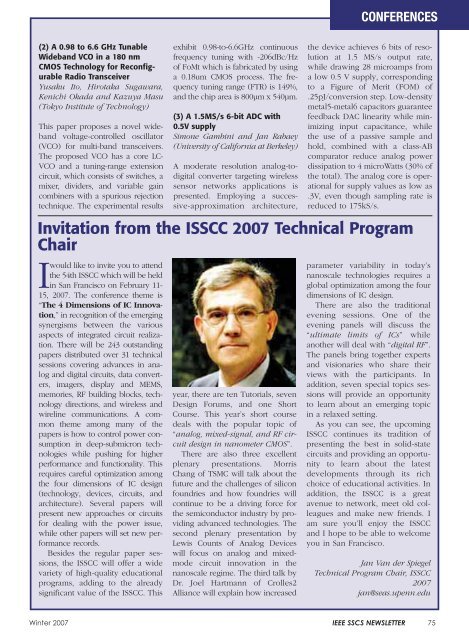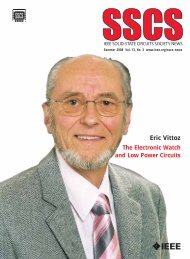The Impact of Dennard's Scaling Theory - IEEE
The Impact of Dennard's Scaling Theory - IEEE
The Impact of Dennard's Scaling Theory - IEEE
- TAGS
- scaling
- www.ieee.org
Create successful ePaper yourself
Turn your PDF publications into a flip-book with our unique Google optimized e-Paper software.
(2) A 0.98 to 6.6 GHz Tunable<br />
Wideband VCO in a 180 nm<br />
CMOS Technology for Reconfigurable<br />
Radio Transceiver<br />
Yusaku Ito, Hirotaka Sugawara,<br />
Kenichi Okada and Kazuya Masu<br />
(Tokyo Institute <strong>of</strong> Technology)<br />
This paper proposes a novel wideband<br />
voltage-controlled oscillator<br />
(VCO) for multi-band transceivers.<br />
<strong>The</strong> proposed VCO has a core LC-<br />
VCO and a tuning-range extension<br />
circuit, which consists <strong>of</strong> switches, a<br />
mixer, dividers, and variable gain<br />
combiners with a spurious rejection<br />
technique. <strong>The</strong> experimental results<br />
exhibit 0.98-to-6.6GHz continuous<br />
frequency tuning with -206dBc/Hz<br />
<strong>of</strong> FoMt which is fabricated by using<br />
a 0.18um CMOS process. <strong>The</strong> frequency<br />
tuning range (FTR) is 149%,<br />
and the chip area is 800µm x 540µm.<br />
(3) A 1.5MS/s 6-bit ADC with<br />
0.5V supply<br />
Simone Gambini and Jan Rabaey<br />
(University <strong>of</strong> California at Berkeley)<br />
A moderate resolution analog-todigital<br />
converter targeting wireless<br />
sensor networks applications is<br />
presented. Employing a successive-approximation<br />
architecture,<br />
CONFERENCES<br />
the device achieves 6 bits <strong>of</strong> resolution<br />
at 1.5 MS/s output rate,<br />
while drawing 28 microamps from<br />
a low 0.5 V supply, corresponding<br />
to a Figure <strong>of</strong> Merit (FOM) <strong>of</strong><br />
.25pJ/conversion step. Low-density<br />
metal5-metal6 capacitors guarantee<br />
feedback DAC linearity while minimizing<br />
input capacitance, while<br />
the use <strong>of</strong> a passive sample and<br />
hold, combined with a class-AB<br />
comparator reduce analog power<br />
dissipation to 4 microWatts (30% <strong>of</strong><br />
the total). <strong>The</strong> analog core is operational<br />
for supply values as low as<br />
.3V, even though sampling rate is<br />
reduced to 175kS/s.<br />
Invitation from the ISSCC 2007 Technical Program<br />
Chair<br />
Iwould like to invite you to attend<br />
the 54th ISSCC which will be held<br />
in San Francisco on February 11-<br />
15, 2007. <strong>The</strong> conference theme is<br />
“<strong>The</strong> 4 Dimensions <strong>of</strong> IC Innovation,”<br />
in recognition <strong>of</strong> the emerging<br />
synergisms between the various<br />
aspects <strong>of</strong> integrated circuit realization.<br />
<strong>The</strong>re will be 243 outstanding<br />
papers distributed over 31 technical<br />
sessions covering advances in analog<br />
and digital circuits, data converters,<br />
imagers, display and MEMS,<br />
memories, RF building blocks, technology<br />
directions, and wireless and<br />
wireline communications. A common<br />
theme among many <strong>of</strong> the<br />
papers is how to control power consumption<br />
in deep-submicron technologies<br />
while pushing for higher<br />
performance and functionality. This<br />
requires careful optimization among<br />
the four dimensions <strong>of</strong> IC design<br />
(technology, devices, circuits, and<br />
architecture). Several papers will<br />
present new approaches or circuits<br />
for dealing with the power issue,<br />
while other papers will set new performance<br />
records.<br />
Besides the regular paper sessions,<br />
the ISSCC will <strong>of</strong>fer a wide<br />
variety <strong>of</strong> high-quality educational<br />
programs, adding to the already<br />
significant value <strong>of</strong> the ISSCC. This<br />
year, there are ten Tutorials, seven<br />
Design Forums, and one Short<br />
Course. This year’s short course<br />
deals with the popular topic <strong>of</strong><br />
“analog, mixed-signal, and RF circuit<br />
design in nanometer CMOS”.<br />
<strong>The</strong>re are also three excellent<br />
plenary presentations. Morris<br />
Chang <strong>of</strong> TSMC will talk about the<br />
future and the challenges <strong>of</strong> silicon<br />
foundries and how foundries will<br />
continue to be a driving force for<br />
the semiconductor industry by providing<br />
advanced technologies. <strong>The</strong><br />
second plenary presentation by<br />
Lewis Counts <strong>of</strong> Analog Devices<br />
will focus on analog and mixedmode<br />
circuit innovation in the<br />
nanoscale regime. <strong>The</strong> third talk by<br />
Dr. Joel Hartmann <strong>of</strong> Crolles2<br />
Alliance will explain how increased<br />
parameter variability in today’s<br />
nanoscale technologies requires a<br />
global optimization among the four<br />
dimensions <strong>of</strong> IC design.<br />
<strong>The</strong>re are also the traditional<br />
evening sessions. One <strong>of</strong> the<br />
evening panels will discuss the<br />
“ultimate limits <strong>of</strong> ICs” while<br />
another will deal with “digital RF”.<br />
<strong>The</strong> panels bring together experts<br />
and visionaries who share their<br />
views with the participants. In<br />
addition, seven special topics sessions<br />
will provide an opportunity<br />
to learn about an emerging topic<br />
in a relaxed setting.<br />
As you can see, the upcoming<br />
ISSCC continues its tradition <strong>of</strong><br />
presenting the best in solid-state<br />
circuits and providing an opportunity<br />
to learn about the latest<br />
developments through its rich<br />
choice <strong>of</strong> educational activities. In<br />
addition, the ISSCC is a great<br />
avenue to network, meet old colleagues<br />
and make new friends. I<br />
am sure you’ll enjoy the ISSCC<br />
and I hope to be able to welcome<br />
you in San Francisco.<br />
Jan Van der Spiegel<br />
Technical Program Chair, ISSCC<br />
2007<br />
jan@seas.upenn.edu<br />
Winter 2007 <strong>IEEE</strong> SSCS NEWSLETTER 75




